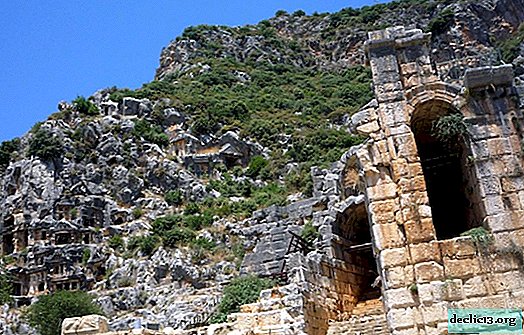Wailing Wall - Ancient Shrine in Israel
The Wailing Wall (Western Wall) is the surviving part of an ancient fortification in the Old City of Jerusalem. It is located on the western side of the Temple Mount and overlooks the spacious area of the Jewish quarter. This building is the greatest religious monument in Israel.

The wall, reaching a length of 450 m, consists of 45 rows of masonry, 17 of them are located underground, and 28 - on the surface of the earth. Its total height is estimated by experts at 32 m, and the open fragment reaches a height of about 19 m.
Interesting to know! This part of the structure is made of huge stones with a smooth surface without the use of any fastening solutions. The length of each stone is from 1.5 to 3 m, the width is 1-1.2 m, the weight is from 2 to 6 tons. One stone, which is called Western, weighs about 570 tons and reaches a length of 13 m.
 Pool Scrution
Pool ScrutionAlong the whole Wall there is an underground tunnel. It begins on the area of the Jewish quarter, goes under the Muslim quarter, goes to the ancient water pipes and ends in front of the Skrution pool, in which under the emperor Adrianorom rainwater was collected for the needs of the townspeople. Going down the tunnel, you can see the part of the monumental structure that is not visible from above. During the excavations, archaeologists discovered numerous finds related to various eras of the history of both the Wailing Wall and the whole of Israel.
History tour
The description of the history of the Kotel in Jerusalem can be made very brief, although in reality the history of the existence of this building has more than one hundred years.

In the 10th century BC By order of King Solomon, a Temple was erected on the Temple Mount, which became the most important shrine for the Jews. In 586 BC it was destroyed by the Babylonians, but after 70 years, the Jews built a new temple there.
In 19 BC e. at the behest of King Herod, the small plateau on which the Temples towered was expanded, and its area became very spacious. So the Temple Mount acquired its present form. This wide area was surrounded on all sides by a solid support wall to support the earthen mound. The current Western Wall is part of that ancient pillar.
In the 70 years BC e., when the First Judean War was going on, the troops of the Roman Empire destroyed almost all of Jerusalem, but the Western Wall survived.
When in 135 AD the Romans crushed the rebellion of the Jews then forbade them to live in Jerusalem. Only in 425 AD e. Jewish people received permission from the Byzantine Empress Eliya Evdokia to live in Jerusalem. In the 7th century, Jews reported another 4 stone rows on top of the Wall, since its lower part was already covered with earthen sediment.

In 1517, Jerusalem passed into the possession of the Turkish Ottoman Empire, and the life of the Jewish people changed for the better. By order of the Sultan Suleiman the Magnificent, a large-scale fortress wall was built around Jerusalem - now it surrounds the Old City. As the story tells, it was Suleiman the Great who allowed the Jews to pray at the Western Wall in Jerusalem, and this happened in the second half of the 16th century. At the same time, another 14 rows of the Wall were completed.

Since the 1800s, the sacred building has become a real stumbling block, reinforcing the feud between the Muslim and Jewish communities living in Jerusalem. Jews repeatedly tried to acquire land and buildings located next to the sacred structure, but Muslims did not allow this. In 1917, the British troops captured Jerusalem, and the situation escalated even more. And when in 1948 the Jordanian army occupied the Old Town, the Jews completely lost the opportunity to approach the Wall.
Only in 1967, during the Six Day War, Israeli soldiers recaptured the Old City, and the Jews again could pray in a sacred place.
Wailing Wall - where does the name come from

Since part of the Temple Mount fortification is located in the west (relative to the ancient Temple), it is called the Western Wall. But why does she bear such a name - the Wailing Wall?
When the Temples were destroyed, the Jews began to gather there and mourn their loss. According to Jewish law, visiting the Western Wall and contemplating the devastation prevailing around, every believer is obliged to cry and tear their clothes. The Arabs, who have repeatedly observed how the Jews weep here about the destroyed Temples, called the ruins of the ancient structure the Wailing Wall.
Interesting to know! Both ancient Temples, which stood on the Temple Mount, succumbed to destruction in one day, only in different years. In the sacred texts it is written that this is not accidental - so the Jews were punished for creating idols for themselves and often provoked bloodshed.
There is another version of why the Wailing Wall in Jerusalem is so called: sometimes drops of moisture appear on the stone, similar to tears. The last time "tearing" was recorded on the Wall in Israel in 1940.
What does the Kotel in Judaism mean?

Why is the Wailing Wall revered by the Jews as the greatest shrine? Only she survived the destruction of the Temples, and she is closest to the Cornerstone on the Temple Mount, which is considered the greatest shrine in Judaism.
The sages say that praying in Israel at the Wall is equivalent to praying in front of the Throne of Glory, because there are the gates of paradise and they are open so that all prayers can be heard. The scriptures say that the Wall is a place where God is always present. All prayers to God have a special power here and are always fulfilled. For centuries, pilgrims have been gathering here to pray, touch the shrine, and strengthen their faith.

People visiting the Western Wall for the first time are amazed at the noise around them: it comes from the crowd of people praying here. During prayer, the Jews usually swing very eagerly on their heels, leaning strongly forward, and some just stand with their forehead resting on a stone shrine.
Find out RATES or book any accommodation using this formGood to know! Most Jews recognize the Western Wall as the most important shrine of Judaism. But there are those who do not visit her, for example, the followers of the Satmar Hasidic court. They argue that the Israeli government has turned the Wall into a tourist attraction, thereby humiliating its holiness.
How to write a note in the Kotel

People have long believed that if you mention the name of a person at this shrine, it will be a good sign. This belief contributed to the emergence of the custom to compose messages with requests to the Almighty and leave them in the Wall. Such a custom has been known for at least three hundred years. Anyone can leave a letter here, regardless of nationality, religion, social status.
How to write a note in the Kotel? Are there any important points to consider when writing?
The type of paper, the color of the ink, the size of the message, as well as the language in which it is written - all this has absolutely no meaning.
Note! What really matters is the way the petition will be written. You cannot create a message to God while experiencing negative feelings (anger, resentment, anger). You need to pray so that love and joy abide in the heart - these are the main conditions for how to write a note to the Wailing Wall.
In the text, it is desirable to express thanks for all that has already been received from God. You can ask only about the most important and most intimate: about getting something really desired, about helping in a difficult situation.

Any crevice between the stones is suitable in order to put a note in it. It is simply amazing how many believers leave them, but everything fits. Religious ministers take out all the messages twice a year and conduct a special burial ceremony with them on Mount of Olives.
Note online or by mailAnd if you can’t go to Jerusalem to the Wailing Wall - how to write a note, how to send it to the shrine?
Important! You can compose a letter and send it by mail or use a special site. The main thing is the power of prayer so that the request is heard!

Thousands of letters come to Israel that say "Israel, Jerusalem, to God." The Israel Post takes them to the synagogue of the Jewish quarter, and the rabbi takes them to the Wall. Volunteers are involved in the maintenance of charitable sites - all requests received on the site are printed and submitted to the Wall.
Compare accommodation prices using this form
What rules should be observed when visiting the Kotel
There are certain rules that must be observed when visiting the Kotel in Jerusalem:

- Men should pray at the left side of the Wall, and women at the right.
- Women should wear clothing covering their shoulders and knees. Men must have a hat. If necessary, you can use the bale - baskets with such free caps are on the square.
- Before you approach the sacred building, you need to wash your hands. For this purpose, special pump rooms with water are installed.
- You cannot take someone else's notes from the Wall and read them.
- Leaving the Wall, you can not turn your back to it - you need to retreat, turning to face the shrine.

And a few more things that everyone who is going to visit the Wailing Wall in Jerusalem must definitely know:
- At each of the entrances to the area control is carried out. Security guards check all visitors with a metal detector, and some are searched. These are security measures that must be taken with understanding.
- Although there are a lot of food stalls on the square, the guards do not let anyone into the stone shrine with food. Just like with pets.
- In order not to distract anyone from prayer, before you approach the Wall, you need to turn off your mobile phone. Engaging in photography and video is prohibited on Shabbat and during Jewish holidays.

It is interesting! In the summer of 2008, Barack Obama posted a note printed on paper from the hotel on the Wall. When Obama and his guards left, a seminary student took out a note and then sold it to the Maariv newspaper. The text of the message was published in the newspaper, which caused a number of critical speeches due to breaches of confidentiality.
Practical information
The Wailing Wall is located in the Old City of Jerusalem (Israel), in the Jewish Quarter. You can visit her anytime - there are praying people there at any time of the day or night.
How to get there Jaffa Gate
Jaffa GateYou can walk to the Wall on two roads:
- From the Jaffa Gate through the Christian quarter, you need to go along the Armenian quarter.
- From the Dung (Garbage) gates you need to go through the Jewish quarter.
If you do not want to go, you can drive to the square on a special tourist train. Departure place - Jaffa and Dung gates. The train runs every day with a frequency of 30 minutes: in the summer from 10:00 to 20:00, and in the winter from 10:00 to 18:00. The train does not run on Saturday, and on Fridays and on the days before the holidays it runs only from 10:00 to 14:00.

Buses No. 1, 3, 51, 83, 746, 882 go from Jerusalem to the Dung Gate. You need to exit at the Dung Gate stop.
Buses 104, 115, 117, 124, 125, 231, 232, 234, 284, 480, 755 go to the Jaffa Gate from Jerusalem. You need to go to the Yaffo Gate stop.
Alternatively, you can take the free shuttle from Jerusalem First Train Station to the Jewish Quarter. It departs with a frequency of 20 minutes on all days of the week, except Saturday: Sunday-Thursday from 08:00 to 20:00, on Friday and other days on the eve of the holiday from 08:00 to 14:00.
Cost of visitingVisit the Wailing Wall, one of the most important shrines located in Israel, is completely free.
On a note! Donations are accepted on the square that go to work to maintain the Wall, and wages to caretakers. It is believed that to leave a donation means to do a good deed.

As you know, the Wailing Wall is visible not only from the square - its underground part can be seen after visiting the tunnel. You can get into it only as part of an excursion group, which is accompanied by a licensed guide. Tourists enter the tunnel from the south side, and exit from the north, the time spent underground is an hour and a half.
Tours are not held on Shabbat and other holidays, on Friday and pre-holiday visits to the dungeon are possible before lunch, on all other days - from 7:00 to 23:00.
Tour cost:
- for adults 35 shekels,
- for pensioners 17.5 shekels,
- for children and students 19 shekels.

















